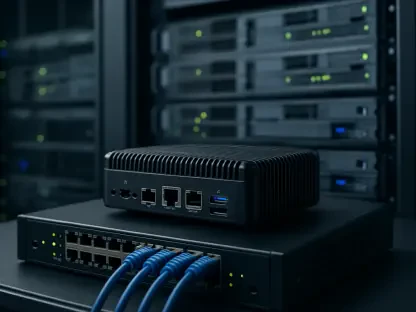Network as a Service (NaaS) is revolutionizing how businesses manage their network infrastructure. Particularly beneficial for small to mid-sized businesses (SMBs), NaaS provides a subscription-based model that offers expertise and configuration tailored to the unique needs of each company. This scalable and flexible approach ensures that businesses only pay for what they use, avoiding large capital expenditures and lengthy depreciation cycles.
Advantages of NaaS
Scalability and Cost Efficiency
NaaS is designed to be highly scalable, allowing businesses to adjust their network services up or down based on demand. This flexibility ensures cost efficiency, as companies can avoid the significant capital expenditures associated with owning and maintaining network infrastructure. SMBs, in particular, benefit from this model, as it allows them to access enterprise-class network capabilities without the need for extensive resources or personnel. Moreover, the pay-as-you-go nature of NaaS enables businesses to align their network spending directly with operational needs, avoiding wasted resources and ensuring that network capabilities can grow alongside the enterprise.
Furthermore, NaaS significantly shortens the lead time for deploying new network services or scaling existing ones. Traditional network setup and upgrades can be time-consuming and complex, requiring substantial investments in hardware, software, and human resources. In contrast, the agility of NaaS allows companies to quickly respond to market demands and evolving technological landscapes without substantial delays. This rapid deployment capability is particularly advantageous in industries where time-to-market and adaptability are critical for maintaining a competitive edge.
Expertise and Customization
Subscribing to a NaaS provider means gaining access to specialized expertise and customized network configurations. Providers tailor their services to meet the specific needs of different industries, such as finance, healthcare, and aerospace. This level of customization ensures that businesses receive the best possible network performance and security, aligned with their unique requirements. For example, a healthcare provider may require stringent data protection protocols and compliance with regulations like HIPAA, while a financial institution may need robust security measures to safeguard sensitive transaction data.
Moreover, NaaS providers often stay at the forefront of technological advancements, investing in the latest innovations in network management and security. This allows subscribing businesses to benefit from cutting-edge technology without having to incur the costs and complexities of maintaining such expertise in-house. The result is a more efficient, secure, and high-performing network environment that can adapt to the specific demands of each business sector. By leveraging the expertise and resources of NaaS providers, companies can focus more on their core activities, driving business growth and innovation.
Challenges and Considerations
Loss of Control
One of the primary concerns with NaaS is the potential loss of control over the network. For larger organizations with dedicated network teams, this can pose significant challenges. Outsourcing network management diminishes direct influence over the network, which may be unsatisfactory for network managers accustomed to hands-on oversight. Additionally, there is a risk of losing skilled personnel if substantial portions of network management are outsourced. These employees might feel their roles have become redundant, leading to decreased job satisfaction and potential resignations, which could subsequently affect the organization’s overall IT competency and continuity.
The erosion of direct control extends beyond day-to-day operations and affects strategic planning and innovation within the network. For instance, an in-house team that traditionally managed network configurations and performance tuning might now rely on the vendor’s service level agreements (SLAs) to guide their expectations and responses. This dependency can limit the organization’s ability to swiftly implement customized solutions or changes based on immediate business needs. Thus, companies must weigh the trade-off between gaining flexibility and expertise from NaaS providers and losing a degree of control and immediacy in their network management capabilities.
Security Concerns
Security is a critical consideration when adopting NaaS, as it operates as a cloud service. Despite rigorous security measures implemented by providers, there is always a risk of breaches. Companies with high-risk intellectual property may find that a NaaS provider’s security standards do not fully align with their stringent protection requirements. It is essential for businesses to thoroughly evaluate the security protocols of potential NaaS providers. This includes understanding the provider’s approach to data encryption, incident response, and compliance with industry-specific regulations to ensure that the outsourced network’s security posture aligns with the company’s internal standards.
Additionally, the shared nature of NaaS infrastructure can introduce vulnerabilities. Multi-tenant environments, where multiple clients share physical or virtual resources, can potentially increase the risk of data breaches or cross-contamination of data. Network managers must assess the segmentation practices and security isolation mechanisms employed by the NaaS provider to ensure adequate protection. Moreover, businesses should consider implementing their oversight mechanisms, such as regular security audits and continuous monitoring, to complement the provider’s safeguards and maintain a proactive stance on security.
Transition and Integration
Migration Complexity
Transitioning to NaaS involves migrating IT assets from internal networks, which can be complex and resource-intensive. This process requires careful planning, time, and financial investment. Network personnel must be involved in the transition to ensure a smooth migration and to address any technical challenges that arise. Key steps include mapping out current network architecture, identifying critical dependencies, and developing a phased migration plan that minimizes disruptions to business operations. Additionally, the involvement of experienced project managers and technical experts can help anticipate and mitigate potential risks associated with the migration process.
Moreover, transitioning to NaaS often requires significant coordination between internal teams and external vendors. Clear communication and well-defined roles are essential to streamline the migration process. Companies need to work closely with their NaaS providers to ensure that all aspects of the transition, from initial setup to ongoing support, are handled efficiently. This collaborative effort includes setting realistic timelines, establishing performance benchmarks, and ensuring that all stakeholders are aligned on the goals and expectations of the migration. By addressing these complexities proactively, businesses can facilitate a successful transition to NaaS while maintaining network stability and performance.
Impact on Application Development
The adoption of NaaS can complicate application development, as network considerations such as throughput and bandwidth are integral to overall performance. Traditionally, network personnel participate in the early stages of system and application design with development teams. Outsourcing the network can impede these collaborative sessions, potentially affecting the development of holistic and efficient applications. Network architects play a crucial role in ensuring that the infrastructure supports application requirements, and their limited involvement in a NaaS model might lead to suboptimal design choices, affecting application performance and user experience.
Additionally, the integration of NaaS with existing development workflows requires significant adjustments. Application developers must work closely with NaaS providers to ensure that network configurations align with the application’s needs. This includes understanding the network’s capabilities, potential limitations, and how changes in network configurations might impact application performance. Regular communication and collaborative workshops can help bridge the gap between development and network teams, ensuring that both parties are aligned on objectives and can collectively address any challenges that arise.
Future of NaaS
Hybrid Network Architecture
As the NaaS market continues to grow, businesses are expected to adopt a hybrid network architecture. This model will involve a mix of NaaS and internal network infrastructure, allowing for bi-directional failovers and ensuring resilience. Mission-critical applications may remain on internal networks, while general tasks and applications can be managed through NaaS. This hybrid approach offers companies the best of both worlds—the flexibility and scalability of NaaS combined with the control and security of on-premises infrastructure for sensitive and high-performance applications.
Moreover, a hybrid architecture facilitates disaster recovery and business continuity planning. By leveraging the strengths of both internal and NaaS resources, organizations can create robust failover strategies that protect against various failure scenarios. For instance, if the internal network experiences an outage, non-essential tasks can seamlessly transition to the NaaS environment, ensuring that operations continue with minimal disruption. Similarly, in the event of issues with the NaaS provider, critical workloads can be reverted to internal systems, maintaining operational integrity. Such resilience is crucial for businesses that need to maintain high availability and reliability in their network services.
Vendor Management Responsibilities
NaaS utilizes a subscription-based model that provides tailored expertise and configuration suited to the distinct needs of each company. This model is highly scalable and flexible, ensuring that companies only pay for the actual services they use. By doing so, businesses can avoid hefty upfront capital expenditures and the long depreciation cycles associated with traditional network setups. This not only leads to significant cost savings but also allows SMBs to quickly adapt to changing demands without being bogged down by outdated infrastructure. Furthermore, NaaS providers offer ongoing support and maintenance, ensuring that businesses remain up-to-date with the latest technologies without needing a dedicated in-house IT team. As a result, small to mid-sized companies can remain competitive and focus on their core operations, leveraging cutting-edge network solutions that were once only available to much larger organizations.









